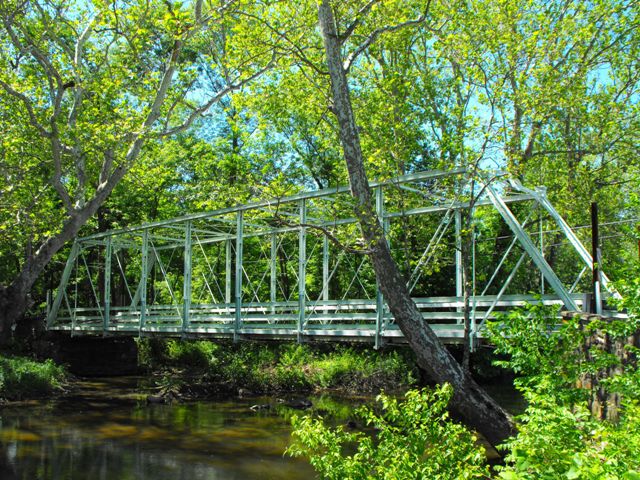We Recommend:
Bach Steel - Experts at historic truss bridge restoration.
Peevy Road Bridge

Primary Photographer(s): Nathan Holth and Rick McOmber
Bridge Documented: May 30, 2010
Rural: Montgomery County, Pennsylvania: United States
1880 By Builder/Contractor: Columbia Bridge Works of Dayton, Ohio
1987
100.0 Feet (30.5 Meters)
103.0 Feet (31.4 Meters)
15.4 Feet (4.69 Meters)
1 Main Span(s)
46704604000231

View Information About HSR Ratings
Bridge Documentation
View Archived National Bridge Inventory Report - Has Additional Details and Evaluation
View Historic American Engineering Record (HAER) Documentation For This Bridge
View A History of David Morrison From Historic American Engineering Record
View A David Morrison Bridge Patent With Some Details Similar To This Bridge

David H. Morrison's Columbia Bridge Works of Dayton, Ohio was noted for its bridges dating from the 1870s through the 1890s that utilized a large number of rolled beams in its members rather than built-up beams that were more common in the period due to the limited size and/or potentially a higher cost of rolled I-beams caused by the limited technology and facilities of the iron/steel mills of the period. In other cases, Morrison designed bridges to use pairs of smaller rolled I-beams which would be held together by square blocks placed between the pairs. The company's widespread use of rolled I-beams was unusual for this period in history. However, the use of rolled beams by the Columbia Bridge Works in the 1880s foretold of a trend that would spread throughout the bridge world, but amazingly not until decades later. In this sense, Columbia Bridge Works was far ahead of its time.
The Columbia Bridge Works, particularly on its earlier bridges like the Peevy Road Bridge, also display an extremely wide range of unusual and distinctive design details that are vastly different from anything seen on other bridges of the time. Columbia Bridge Works simply did not conform to any of the traditional truss and beam details in use during the period. Even if the the bridges do not retain the distinctive, ornate builder plaques, the identity of Columbia Bridge Works bridges is painfully obvious by way of the design.

The Peevy Road Bridge displays a particularly wide range and unaltered set of these unusual details. The struts on the bridge are rolled I-beams. The top chord and end posts are an unusual design composed of a rolled I-beam with a rolled angle riveted to the to each flange. The vertical members of the bridge are two rolled I-beams which are held together with "packing blocks" placed between the pairs and riveted to the I-beams. The bottom chord of the bridge is composed of simple flat bars without eyes, similar to the bottom chords that appeared on many bowstring arch/truss bridges of the 1870s. The bottom chord sections are spliced near the bottom chord connections via trios of small pins, a most unusual detail. The diagonal members of the bridge are equally unusual. Some of the diagonals are rods that end in eyes short of the top or bottom chord and are attached to short pairs of bars by a pin. These bars in turn run the remaining distance and connect to the actual bottom chord connection. On the top chord, some of the diagonal members instead run through the top chord and are connected to the top chord by way of the threaded rod and nut method similar to that often seen on those bowstring arch/truss bridges of the 1870s. Finally the general design of the bridge's bearing and shoe casting is atypical, partly on account of the abnormal design of the end post and the bottom chord. Here, the end post terminates in a three-fingered casting that has a pin running through it as well as the two bottom chord bars and the cast "shoe" that also functions as a sole plate for the bearing.

This bridge is considered by the Historic Bridge Inventory to be one of the most significant bridges in Pennsylvania that documents the development of the metal truss bridge. HistoricBridges.org agrees with this assessment. Among the small collection of Columbia Bridge Works bridges surviving in the country, this bridge stands out as one of the least altered and early examples, and also one of the examples that displays the greatest quantity and variety of unusual design details that defines the Columbia Bridge Works identity. The beautifully decorated bridge retains good aesthetic integrity as well, with plaques remaining as well as the beautiful cast iron caps that fit over the top of the end posts and the ends of the top chord. The ornate portal bracing knee castings remain as well. The only major thing missing on the bridge is its original railings. Based on the empty holes seen on the vertical members and end posts, it appears that the original railings were very lightweight pole railings.
The bridge remains in decent condition and because of its significance, the bridge should be given high preservation priority, and any rehabilitation projects for this bridge should be carefully designed to be respective of the historic integrity of the bridge. Future work on the bridge should also include the removal of the existing railings which are not original and installation of railings that are not mounted to the trusses and are instead mounted into the deck. This will protect the historic bridge trusses from possible damage during a vehicular collision.
Information and Findings From Pennsylvania's Historic Bridge InventoryDiscussion of Bridge The one span, 102'-long metal Pratt thru truss bridge is supported on concrete-capped stone abutments with flared wingwalls. It is one of the most important bridges in the state illustrating the evolution of metal truss bridge technology, and it is historically and technologically significant . It is remarkably complete, and it has idiosyncratic details that reflect designer David H. Morrison's thinking about truss members and connections including the "hollow cylinder" verticals with "packing blocks" and the "flat bar chords." Discussion of Surrounding Area The single lane bridge carries a township road over a stream in a forested setting with a late-19th century brick house and a stone and brick mill building beyond one quadrant. The other quadrants are wooded. The bridge is at a T intersection. Bridge Considered Historic By Survey: Yes |
![]()
Photo Galleries and Videos: Peevy Road Bridge
Bridge Photo-Documentation
Original / Full Size PhotosA collection of overview and detail photos. This gallery offers photos in the highest available resolution and file size in a touch-friendly popup viewer.
Alternatively, Browse Without Using Viewer
![]()
Bridge Photo-Documentation
Mobile Optimized PhotosA collection of overview and detail photos. This gallery features data-friendly, fast-loading photos in a touch-friendly popup viewer.
Alternatively, Browse Without Using Viewer
![]()
Westbound Crossing of the Bridge
Full Motion VideoStreaming video of the bridge. Also includes a higher quality downloadable video for greater clarity or offline viewing.
![]()
Eastbound Crossing of the Bridge
Full Motion VideoStreaming video of the bridge. Also includes a higher quality downloadable video for greater clarity or offline viewing.
![]()
Another Westbound Crossing
Full Motion VideoStreaming video of the bridge. Also includes a higher quality downloadable video for greater clarity or offline viewing.
![]()
Maps and Links: Peevy Road Bridge
Coordinates (Latitude, Longitude):
Search For Additional Bridge Listings:
Bridgehunter.com: View listed bridges within 0.5 miles (0.8 kilometers) of this bridge.
Bridgehunter.com: View listed bridges within 10 miles (16 kilometers) of this bridge.
Additional Maps:
Google Streetview (If Available)
GeoHack (Additional Links and Coordinates)
Apple Maps (Via DuckDuckGo Search)
Apple Maps (Apple devices only)
Android: Open Location In Your Map or GPS App
Flickr Gallery (Find Nearby Photos)
Wikimedia Commons (Find Nearby Photos)
Directions Via Sygic For Android
Directions Via Sygic For iOS and Android Dolphin Browser
USGS National Map (United States Only)
Historical USGS Topo Maps (United States Only)
Historic Aerials (United States Only)
CalTopo Maps (United States Only)



